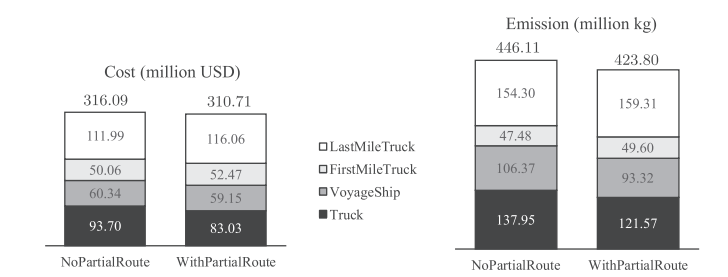Artificial Intelligence in ports

Author: Anastasia Kiritsi, Lecturer & Researcher
The concept of multimodal transport usage were used to the development of an efficient transit plan of Inter-state transport pathways linking the main harbors in the United States. After the construction of the model, the same number of criteria was shown as an efficient transit map of Interstate transit routes connecting major US ports. In order to strengthen the argument for the use of Multimodal Logistics in the Maritime Sector, this study pulls Multimodal Logistics variables and models them using Artificial Intelligence to show a large opportunity to rationalize costs, boost efficiency, and reduce carbon emissions. The same number of factors is predicted as an effective transportation plan of Inter-state transit routes joining node network configuration after model construction.
 IHow a multimodal can be built and used to make decisions in supply chain organizations?
IHow a multimodal can be built and used to make decisions in supply chain organizations?
The goal of this research is to create a model based on the notion of risk management and sophisticated mathematical tools in order to provide transparency and visibility, and therefore a better degree of decision making for supply chain organizations and performance. With increased globalization, multinational commerce firms have discovered that regulating all elements of their operations has become tough, especially when it comes to risk management. To address these issues, research in the topic of supply chain risk management has been conducted, and the literature has been extensively filled.
The goal of this research is to create a model based on the notion of risk management and sophisticated mathematical tools in order to provide transparency, visibility, and, as a result, a higher degree of decision making for supply chain organizations and performance.
the climate change, environmental degradation, and the depletion of energy supplies are all major challenges for shipping in the twenty-first century. Seaports are an integral part of the shipping industry’s infrastructure. Although there is no universal answer, seaports all over the world suffer the same problem. The problems in integrating new technology into automation, traffic congestion, harmonizing residential neighborhoods surrounding the port, measuring and lowering CO2 emissions, and preparing for the energy transition are among the issues mentioned. Furthermore, strengthening the resilience of port infrastructure in the context of increased market demand, workforce shortages, and rising pricing should be considered.t cities worldwide. This expanding significance stems from the necessity for politicians, city managers, port authorities, local administrators, shipping businesses, and couriers to establish increasingly digitalized and sustainable logistical procedures. Finally, there is limited overlap between present definitions and little parallels across ports in terms of future paths to become more effective or ecological. Smart ports are innovative port infrastructures that use cutting-edge technologies and equipment to support ship and cargo operations. A smart port is one that employs automated technology and digitalization to boost productivity and save costs across the board. As a result, smart ports are frequently regarded as one answer for minimizing shipping’s environmental effect.
Modeling approach:
The paradigm is the foundation for the smart multi-modal hubs architecture employing AI. The system is based on the regeneration of all (or a subset of all) viable sailing paths, which are then fed into the model as input. The model suggested here, on the other hand, incorporates two significant extensions, which are as follows:
The end goal – the »vision« -is defined by people and its feasibility based on re-sources. The vision can be abstract, for example »increase turnover by 10 % in three years’ time«, but achieving is a prac-tical exercise, for example by establishing an asynchronous data processing auto-mation PLM environment.
Designing partial routes
Every voyage is a succession of sites a boat stops at. As there are several manufacturing facilities, it might be advantageous to establish more advanced route topologies in which several ports could be met again [7].
As a result, all conveyor belt paths are regenerated. Additionally, as the number of locations rises, the number of fundamental cyclic pathways, where each location is only accessed once, climbs rapidly. Along with the option of visiting each port again will boost this figure by an exponential ratio. As a result, we present partial routes in this study to efficiently describe highly generic route architectures. A fragmentary route is something that does not follow a circle, starting from one terminal (load) to the next terminal (unload). One can simulate conveyor belt pathways without significantly increasing the variety of feasible regenerated pathways by cleverly integrating such partial pathways. In the MIP paradigm, we generate a component for every combination of paths and boat types, therefore we dramatically minimize the amount of parameters when contrasted to producing all conveyor belt pathways [7].
Customizing sailing speed
Usually, a ship’s fuel usage is a non-linear convex relation of traveling pace. The boats’ fuel usage and, thus, their fuel expenditures are greatly influenced by the traveling pace that is selected. Hence, including velocity as a weighting factor may have an impact upon the most cost-effective layout of the multi-modal transmission systems. Thus, the choice of traveling pace has a significant impact on fuel use and expense. For the sake of convenience, we had opted to use a range of distinct velocity alternatives among the lowest and highest operational rate in order to calculate the boat’s fuel usage [7].
Result and Analysis:
The findings of the statistical investigation are provided and explored further below. It begins by comparing the outcomes of various organizing goals (i.e. reducing price vs. emanations). The results of simple vehicle transportation are then contrasted before assessing the impact of speed augmentation. Lastly, the impact of providing partial pathways that may be integrated into conveyor belt pathways is explored before investigating the impact of coordination between automakers at the two distinct sources [7]
Contrasting findings of reducing prices vs. reducing emanations
Figure 1 depicts a contrast of price and emission elements for the multi-modal distribution system while reducing prices (Purpose 1) and emanations (Purpose 2), correspondingly. While reducing emissions, the integrated price in target function increased by a very tiny constant to guarantee that the option with the least price is picked across all alternatives that are optimum in terms of emissions [7].
As indicated in Figure 1 (a), the overall price of the approach when expenses are minimized is 310.71 million USD, but the price is approximately 5% more once emissions are minimized. Figure 1 (b) illustrates the discharges of the approaches when pursuing the 2 distinct aims. It is clear that restricting releases decreases CO2 emissions by only around 2.6% contrasted to reducing prices (i.e. 412.98 million kg vs. 423.80 million kg). This shows that there is no inherent conflict between the two objectives, and that the most cost-effective approach is also quite effective in terms of reducing emissions [7].
The key distinction among the two methods is that while limiting emissions, a greater proportion of multi-modal transportation (coastal transport) is chosen, 72% versus 65%. It is proven possible by the larger boat fleets used in this strategy that includes every ship types, whereas the cost-effective alternative only contains two ships of the biggest kind. Other significant distinction among the two strategies is that, predictably, in the emission-optimal strategy, virtually all picked journeys (98%) are flown at the slowest possible pace to decrease fuel usage and, hence, emanation. In this approach, the fastest speed is not selected at all, however all velocity options are utilized in the price-optimization approach. However, up to 69% of flights are only conducted at the lowest latency, therefore sailing at slow speeds appears to be advantageous from a cost-perspective as well [7].
![Figure 1 (a) [7] 1](https://maritimes.gr/wp-content/uploads/2023/05/1.png)
Figure 1 (a) [7]
![Figure 1 (b) [7] 2](https://maritimes.gr/wp-content/uploads/2023/05/2.png)
Figure 1 (b) [7]
Effect from introducing partial routes
This can be observed that adopting partial pathways results in cost and emanation reductions. While there is a 1.6% cost reduction (311 M dollars vs. 31 M dollars), the reduction in emanations is closer to 5%. The main distinction is that when partial routes are included, multimodal transmission comprises a bigger percentage of overall transportation, 65.4% vs. 62.1%. All routes selected in the ideal approach include two or three port visits.
Impact of optimal velocity
Another of the enhancements explored in this study is the potential of improving ship sailing pace, which may have a significant impact on fuel usage (and expenses), and hence emanation.

Figure 2 [7]
Conclusion:
Multi-modal transport utilizes many forms of transportation and could be an efficient method to mitigate the adverse ecological consequences of freight transit.
This study considers a multi-modal transmission system construction challenge with the goal of optimizing economic and ecological advantages. The transmission system under consideration comprises ships transit. We suggested a novel mixed integer programming (MIP) paradigm that determines the ideal system architecture, such as the number of boats of different kinds to utilize, their related pathways, and traveling velocities. It also recommends the best freight flow via the system. The results of the current study show that multimodal transmission would be both financially beneficial and ecologically friendly, particularly when more commercial entities join forces to create economies of scale. The findings revealed that adopting multi-modal transport instead of solely straight truck delivery, which is often utilized now, may save an estimated 25.9% in costs. The decrease was much greater, at 35.8%. According to the most cost-effective option, up to 65.4% of autos should be carried by coastal shipping. When emanations were minimized, cost savings were remained approximately 22%, and emanations were decreased by up to 37.5% when contrasted to solely direct vehicle transportation
Published article on Artificial Intelligence in Ports at the prestigious HANSA:
